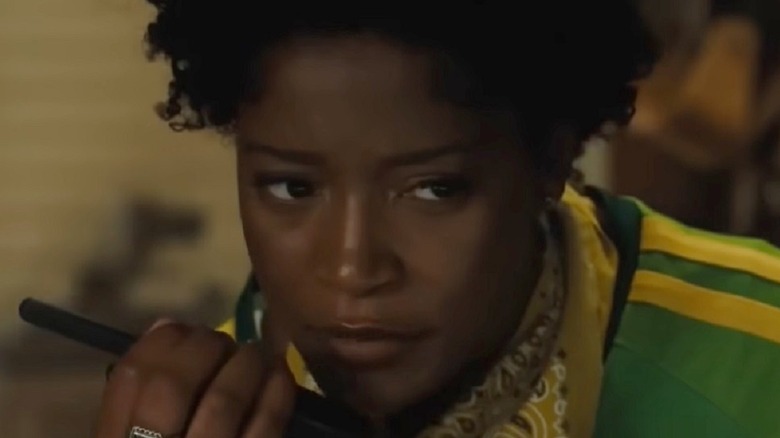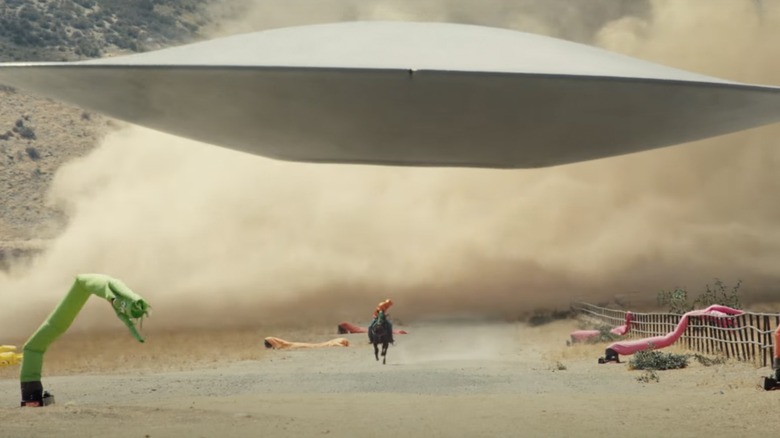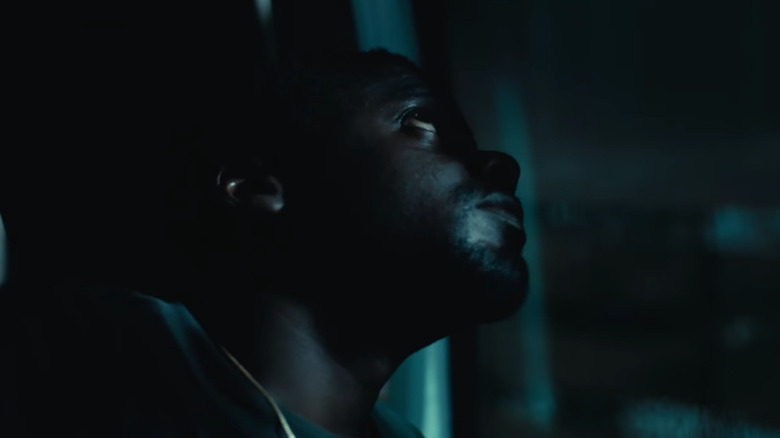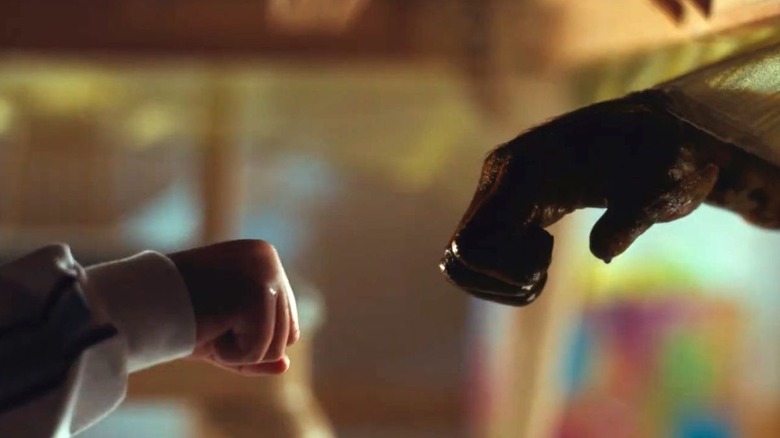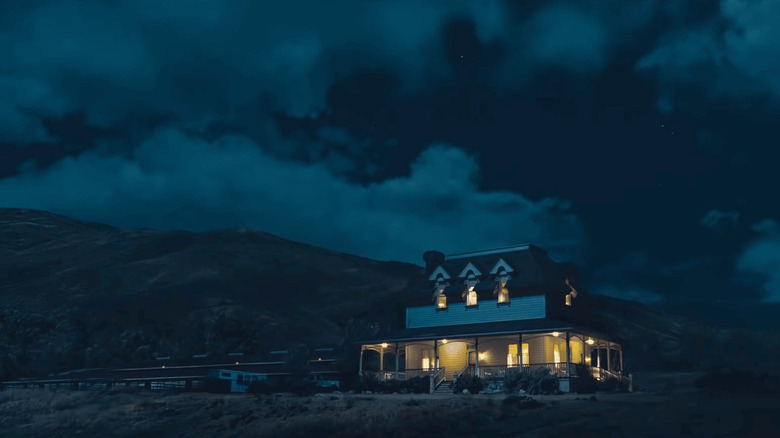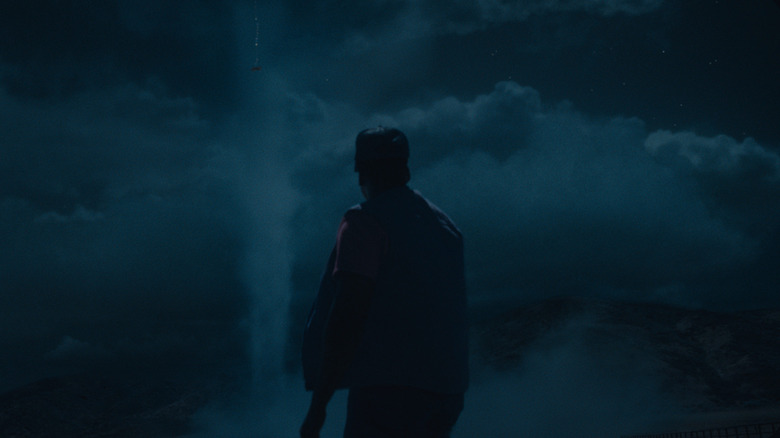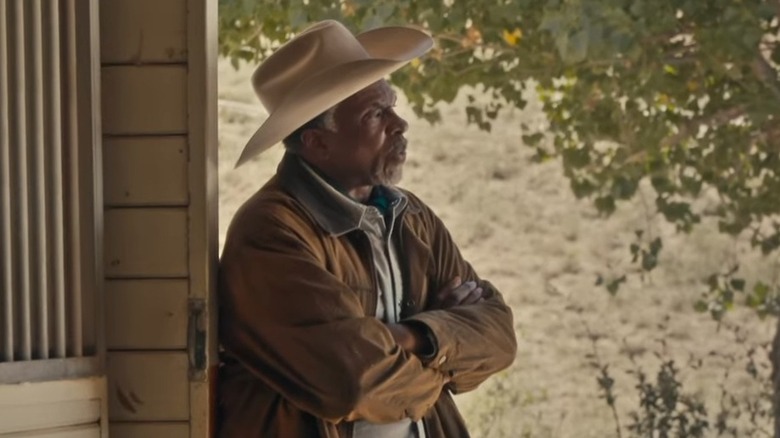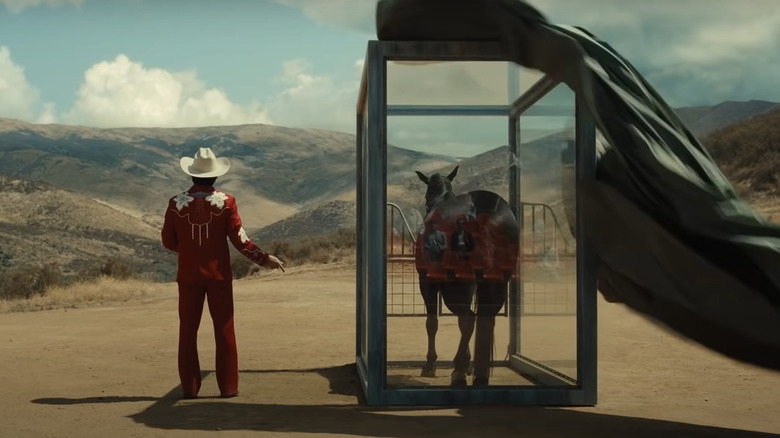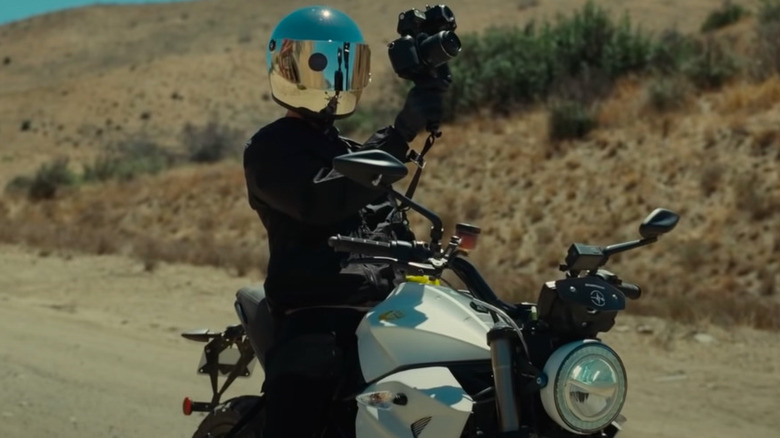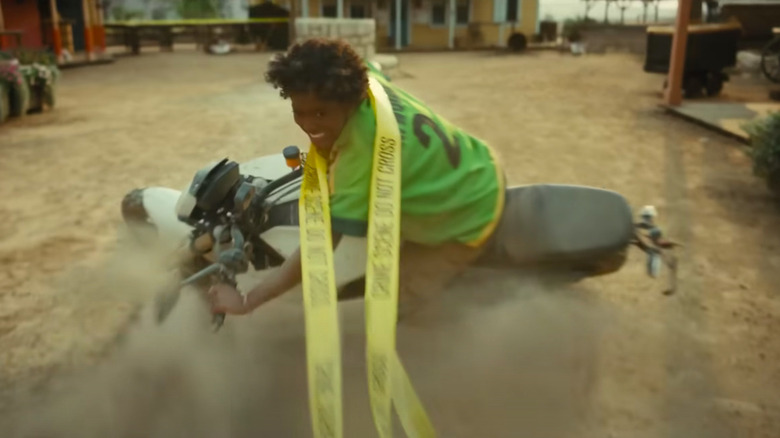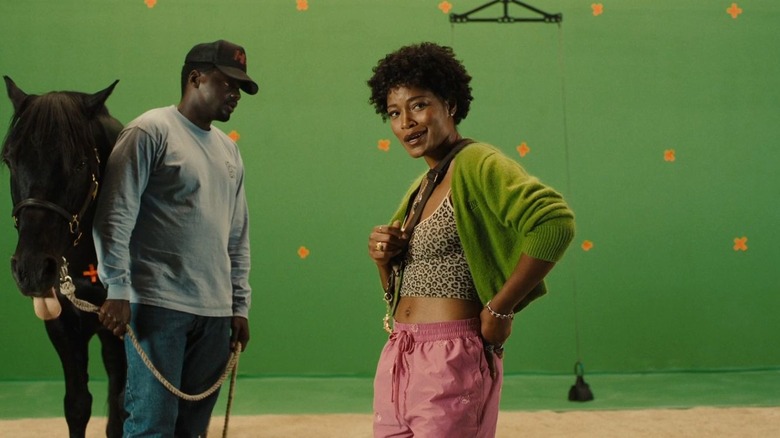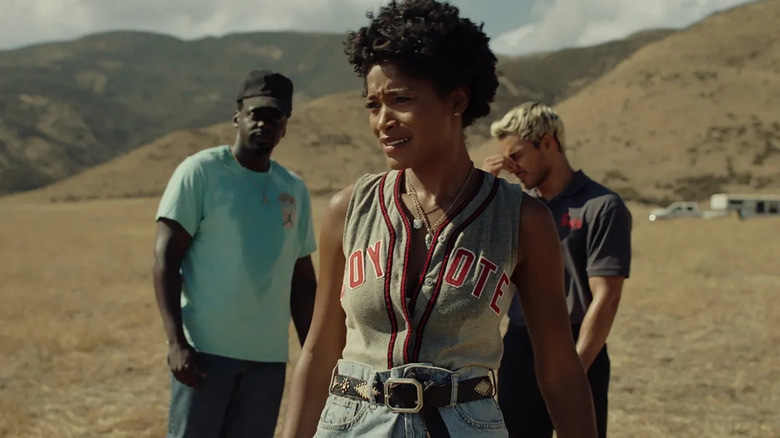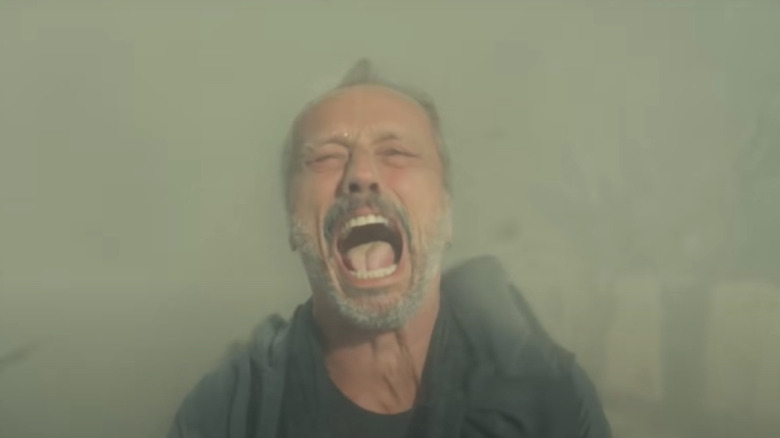6 Best And 6 Worst Things In Nope
The reviews are in, and critics have given their seal of approval to Jordan Peele's latest horror masterpiece, "Nope." The film follows a pair of horse ranchers, OJ and Emerald Hayward (Daniel Kaluuya and Keke Palmer), who suddenly find themselves fighting to survive against a mysterious UFO that terrorizes the Agua Dulce desert. The supporting cast includes Steven Yuen, Michael Wincott, and Brandon Perea, as well as Keith David in a small but pivotal role.
Thanks to its mix of tense horror, social commentary, and small bursts of character-driven comedy, "Nope" is another success for Jordan Peele, just like the writer-director's previous efforts, "Get Out" and "Us." That's not to say it's a perfect film, however. There are some quibbles to be had with the film. Though none of them derail the experience, we still have some nitpicks to share. Here are our picks for the 6 Best and 6 worst things in "Nope." Be warned, this story is chock full of spoilers.
Best: The UFO escalation
"Nope" is exceptionally well-paced. Every time the UFO shows up, the audience learns a little bit more about it. At first, it's shown in fleeting glimpses as it flies off into the distance. As the characters grow more aware and are able to prepare for the UFO, they get a clearer view of exactly what they're up against, and so does the audience. By the end of the film, the characters and the audience know a lot about the UFO, its true nature, and even how to effectively fight against it.
Pacing is crucial in a horror movie, especially when it comes to unraveling various layers of mystery. If the movie shows all of its cards too soon, there's no tension left to sustain the rest of the movie. On the other hand, if the movie ends without offering at least some answers to the viewer, then they feel cheated. "Nope" does a great job and allowing the audience to learn about the UFO and its mysteries, while still leaving enough unanswered questions to fuel rampant speculation.
Worst: The don't make eye contact rule
The UFO is not a vehicle that carries aliens, but an alien creature itself. OJ, a trained animal wrangler, deduces that the UFO only attacks people who look it in the eye. He's able to use this knowledge to fight against the UFO, tricking it into eating things that disagree with its stomach. However, the exact rules for this are somewhat unclear. Sometimes, the UFO has an omniscient ability to detect if it's making eye contact, while other times characters can briefly look at it before averting their gaze and securing their own safety.
One odd example occurs near the end of the movie, when the UFO devours the "TMZ Guy," as he's called. The character's face is entirely unseen, and he wears a reflective motorcycle helmet with only a single hole for his right eye to peer out. Oddly, despite being nearly impossible for the viewer to see his eye, he gets killed because he makes eye contact with the UFO, which proceeds to hunt him down after noticing him looking up at it. It's possible the alien is triggered more by his reflective helmet, calling back to an earlier scene involving a horse attacking after seeing its own reflection, but it's unclear exactly why the UFO kills the "TMZ Guy." Then again, that's part of the movie's theme; wild animals don't always behave the way we expect, and it's folly to think we can control nature's creatures.
Best: The commentary on sensationalism
One of the central themes in "Nope" is the idea of how tragedy gets diminished and sensationalized. Steven Yuen's character, Ricky Park, starred in a sitcom with a chimpanzee. One day, the ape was startled by a popping balloon and went on a rampage, injuring no fewer than two of its co-stars, even going so far as to tear off a woman's face. At his ranch in the present day, Ricky has something of a shrine to Gordy the Chimp, complete with souvenirs and a MAD Magazine parodying the incident. He even recalls a "Saturday Night Live" sketch featuring Chris Kattan as Gordy. When he becomes aware of the UFO, he doesn't call the authorities but attempts to turn the beast into an attraction at his desert theme park, promising his guests that they will see a "spectacle." It does not end well for Ricky and his guests.
Even though they're the heroes, OJ and Emerald similarly seek fortune and glory for themselves by attempting to capture photographic evidence of the UFO. (By the way, it's probably no coincidence that OJ's name may remind audiences of OJ Simpson, one of the most sensationalized figures of the 1990s whose double murder trial was intensely scrutinized by the media and the public at large — but that's a discussion for another day.)
Worst: Where's the federal government?
Even though OJ and Emerald keep to themselves and don't alert the authorities of the UFO hovering over their property, it's still a bit odd that no authorities ever come along to investigate. When the "TMZ Guy" comes to the farm, he mentions that the entire region is blurred out on Google Maps. If that were really the case, one would think the FBI or the CIA or some kind of government agency would start snooping around.
While it might seem unrealistic, it makes sense why Jordan Peele wouldn't want to include government agents in "Nope." After all, not every alien-related story needs a version of Agents Mulder and Scully running around trying to make sense of it. Simply put, it's not their story; it's OJ and Emerald's story. Still, it feels like some of the story's believability is lost by the absence of some sort of ominous "men in black" figures. Perhaps setting the story in a more remote location or simply removing the line from the "TMZ Guy" about Google Maps would have avoided drawing attention to this admittedly minor issue.
Best: The special effects
"Nope" is a visually gorgeous movie. It uses stunningly photorealistic CGI effects to bring the UFO to life. Gordy the Chimp is also a fully CGI character, portrayed by motion capture master Terry Notary. But it's not just about the CGI, since there are lots of amazing practical effects, including when the UFO shakes the farmhouse and spills a goopy mix of blood and viscera all over the place.
Visually, the most memorable moment in "Nope" is also its scariest; when Ricky Park and the attendees of his theme park are devoured by the UFO. The audience actually gets to see what it's like for the people inside the UFO, as they're squeezed into an increasingly tight tube that resembles a monstrous throat. It's a harrowing and terrifying moment and it's shot beautifully, leaving little to the imagination while tastefully refraining from showing too much R-rated gore.
Visually, "Nope" is a feast. By the time of the final showdown against the UFO, all pretense of hiding its form is rightfully abandoned. The sequence, set in broad daylight, works because it's a full-tilt battle of wit versus instinct. The UFO isn't hiding anymore; it's hunting. Thankfully, the CGI effects are always good enough to withstand the cold light of day.
Worst: Not enough Keith David
Keith David plays an important role in "Nope," but he doesn't get a lot of screen time. Notably, he dies before he's even listed in the opening credits. Though he appears in a flashback scene later on, it's not an extended sequence, and the vast majority of David's performance can be seen in the first several minutes of "Nope."
Born in 1956, Keith David is a living legend, having played roles in films like "They Live," "The Thing," and "Platoon." His booming voice is unmistakable, and a legion of video game enthusiasts will instantly recognize his vocal stylings from titles like "Modern Warfare 2" and "Saints Row 4." It's nice to see him in "Nope," but it's still somewhat disappointing that he's killed off so quickly. Of course, his death is integral to the story, and largely informs the character of OJ as he seeks to carve out a legacy for himself and make his late father proud. "Nope" gives Keith David room to shine, but more scenes with him would have been better; more Keith David is always better.
Best: The animal terror
While the main story of "Nope" revolves around OJ and Emerald fighting against a UFO, much of the film's earlier terror comes from a more terrestrial source. The very first scene shows the aftermath of Gordy the Chimp's rampage on the set of his sitcom, with the simian critter covered in blood while wandering around the set. When "Nope" returns to that scene later on, it shows the raw power and terror of an unhinged ape as it brutalizes multiple people. While the audience is spared the sight of Gordy ripping off a woman's face, hearing it happen just offscreen is still enough to be disgusting and deeply unsettling.
Another early scene shows the danger of disrespecting the power of a wild beast. OJ and Emerald bring their horse, Lucky, to the set of a Hollywood movie. While he tries to get the movie crew to respect Lucky's space, he's too timid to muster up any real authority, and the filmmakers essentially walk all over him. One unlucky crew member nearly pays the ultimate price when Lucky is spooked by the sight of a lighting technician's reflective ball, which causes the horse to see its own reflection and reflexively kick behind it. Its powerful hooves come within inches of killing a random crew member. The horse wranglers are fired from the film, and Lucky is replaced with a CGI animal; it's probably safer that way.
Worst: TMZ guy
The final act of "Nope," while thrilling, is arguably the weakest part of the film, with more contrived plot developments and inconsistent behavior from its characters. The worst part of this sequence is "TMZ Guy," an inexplicable character who shows up and tries to capture the UFO on film, much to the Haywood siblings' chagrin.
"TMZ Guy" ignores the warnings from Emerald and drives his electric motorcycle toward the UFO. Thanks to the alien's anti-electric powers, the bike shorts out and crashes, sending "TMZ Guy" tumbling to the ground. OJ tries to rescue the injured photographer, but there's no time, and the "TMZ Guy" is too belligerent to be reasoned with, insisting on getting his camera back before he allows OJ to save his life; maybe he's just in shock.
OJ tries to save him, but when it becomes clear that the UFO has decided to make the "TMZ Guy" his next victim, OJ makes the pragmatic decision to abandon him, at which point the reporter is unceremoniously killed by the alien. If his entire role was completely removed, it wouldn't change the movie in any meaningful way. Much like the real TMZ, "TMZ Guy" isn't much more than a waste of time — but at least his reflective motorcycle helmet looked pretty cool.
Best: Motorcycle action
Actually, if the "TMZ Guy" serves any real purpose in "Nope," it's that he rides into the scene on a sweet electric motorcycle. His bike crash is a pretty impressive stunt, but when Emerald races to the bike and gets it started, that's when the action really kicks off.
Indeed, she makes good use of the two-wheeled vehicle, driving at critical speed through the desert and leaving big clouds of dust in her wake. She even gets to pay homage to the iconic power slide shot from "Akira" when she stops at her destination. Still, it does raise the question as to how Emerald was going to race the UFO to Ricky Park's amusement park since the "TMZ Guy" arriving was an unexpected variable. Since much of the actual plan goes unstated leading into the final act, it's unclear whether Emerald improvised leading the UFO to Park's fairground or if she had another plan to get there, perhaps riding on the back of OJ's horse. Either way, we're not going to criticizethe film's exciting motorcycle action. That's like looking a gift horse in the mouth — or a gift motorcycle, in this case.
Worst: Emerald (at first)
While Daniel Kaluuya takes top billing as OJ, Keke Palmer steals the show as his sister, Emerald. There's only one problem: She's an extremely annoying character at first. While it's amusing how she self-promotes while introducing OJ and Lucky to the Hollywood film crew in the early part of the film, OJ is absolutely right when he angrily rebukes her for selling herself, rather than their business. Furthermore, her playing of loud music at the farmhouse causes one of the horses to run away scared, forcing OJ to go out into the desert in an attempt to get it back.
Thankfully, even when she's being a pest, Emerald is still an entertaining pest. Even OJ can't stay mad at her for too long, since their sibling bond is strong enough to overlook her minor flaws, just as she overlooks his off-putting ice-cold demeanor. Still, in the early stages of "Nope," Emerald can be more of a detriment than a boon to the film.
Best: Emerald (eventually)
Fortunately, once it becomes clear that OJ and Emerald are dealing with a very real threat and that they have to work together to accomplish their goals of surviving and capturing the UFO on film, Emerald becomes a much more amenable figure. While she remains a jolly character throughout, Emerald takes things much more seriously once the situation begins to escalate. She works closely with Angel the electronics expert to understand how their camera equipment works, and she is the one who gets the idea to bring in Antlers Holst (Michael Wincott) to get the best possible shot of the UFO.
Best of all, in the film's closing minutes, Emerald is the one who defeats the UFO by tricking it into eating a giant balloon that explodes within its gullet, causing significant, likely fatal, damage to the alien. Keke Palmer deserves all the praise in the world for her performance, which is equally vulnerable, empowering, and entertaining.
Worst: Holst's impossible shot
Michael Wincott plays Antlers Holst, a world-class Hollywood cinematographer who is recruited by Emerald to help capture photographic evidence of the UFO. He's driven by a desire to film what the characters in the film call "the impossible shot." But for Holst, who is seen watching a macabre nature documentary of a tiger and a giant snake locked in a battle to the death, "the impossible shot" isn't just the sight of a UFO.
While OJ lures the UFO into position, Holst and Angel take a camouflaged position up on a hill. Everything goes perfectly according to plan and Holst captures the UFO on film using his homemade camera that operates entirely without electricity, bypassing the alien's anti-electrical properties. However, it's not enough for him. After shooing away Angel, Holst gives up his position, stares the alien in the eye, and films as he's killed by the UFO.
Holst gets what he wanted: his "impossible shot," and he got it entirely for himself, not for anybody else or their commercial reasons. Still, Holst's death feels a bit silly, especially when comparing Holst to the more pragmatic Hayward siblings, who fully intend to reap the fortune and glory of capturing the alien on film. It makes sense that Holst and the Haywards are thematic counterpoints to each other, but it feels like Holst could have used an extra scene to flesh out his character and more properly contextualize his death scene.
